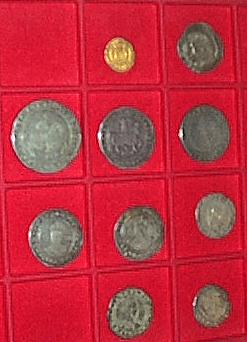
October 19th 2001.
Next club meeting - Monday 5th. November 2001.
Meetings are held at the Abbey Baptist Church, Abbey Square, commencing at 7.00 p.m.
October meeting
Joe Bispham gave an excellent talk, covering the coinage of the first three Tudor Monarchs, Henry VII, Henry VIII and Edward VI. He gave an historical perspective to the coinage, both in terms of the political situation but also in terms of the artistic developments of the time. Tudor coins were full of symbolism, for example, the Rose and the portcullis (possibly 'two door' for 'Tudor').
The portraits used for the Henry VII coinage by Alexander of Brugsal, have an Italian Renaissance influence and are believed to be based on a terracotta bust of the King. It was during this reign that the first English pound (sovereign) was minted and also a trial piece for the first shilling or testoon.
For the first 16 years of Henry VIIIs reign, the coinage continued much as Henry VII. However, by then, foreign coins of less fine metal were coming into the country and English coin was leaving the country. To counteract this, a new coinage was issued, supervised by Wolsey. The coinage was of a lesser weight than before and consisted of the noble(6s 8d) half noble, crown of the double rose(5s) and double crown of the double rose. The portraits are thought to have been taken from Holbein, a favourite of Henry who gave him a gilt cup after Holbein had painted a portrait of Edward VI for the King which Henry much admired. Wolsey saw fit to issue a groat of his own, something which was the King's prerogative, which fact was used against him during his indictment.
Henry VIII then set about debasing the coinage, in order to raise money to fund the wars with France. Silver went to 9 and eventually 4oz fine by 1546. Gold dropped from 23 to 20. The workers at the mints complained that the silver and base metals would not mix well at such low concentrations of silver and pleaded for the mix to be improved. When the silver coins wore, the base metal would show through and with the highest part of the coin being the King's nose, this led to the King being called 'old coppernose'.
The portraits for Edward VI's coins were by Stott. The coinage designs used 'frosting' for the first time, another introduction from Italy. The first issues were the 'Bare Headed' pieces. Why such pieces were issued is not known, but one possibility is that Edward VI was shown uncrowned because he was still under the protector. These issues were very short lived and crowned busts appeared thereafter. Posthumous issues of Henry VIII were also made in this reign up to 1551. A lot of the metal for the coinage came from Chancery plate and this reign also saw the fineness of the silver drop to 3oz, in 150,000 pounds struck to pay off debts. Debasement of the coinage made a great deal of money for Henry VIII (estimated at 1.2 Million pounds) but also for the under-treasurers.
Early issues in this reign were a 1s at 8oz fine and a groat at 4oz fine silver. These coins were so similar that they were mistaken for each other. A leading bishop complained of being passed a lowly groat for a shilling and the coins were withdrawn after 3 weeks.
In 1550 Edward made a 'Royal Progress' and issued a gold coinage to go with it. These pieces are very rare and were used as presentation pieces for visiting dignitaries. The third coinage introduced both the silver halfcrown and the threepence into English coinage.
We had a visitor from Canada, Ross Blakey, who is president of the London Numsmatic Club (in Ontario Canada). He passed around a copy of their newsletter and a medallion struck in anniversary of their club, which was founded in 1951. He also showed several members photos of his excellent collection of hammered coins, we are very grateful for the interest he showed and the effort he made to get to the club.

There were 21 members and 3 guests, 5 dealers tables. The member's display was provided by Maurice, being a selection of Tudor coins.
Auction
The club auction will take place at the 7th January and lots are required on or before the December meeting. So please bring along your lots to either of the next 2 meetings and hand them to any committee member. If we all put in just a few items we can make this an enjoyable and successful evening.
Subscriptions
For those who have not yet renewed their subscription for 2001/2002 these are now due and remain at the same rate as last year - £12. Please send your subscriptions to Maurice or hand them to a committee member.
Future Events.
Davidson Monk Coin Fair at the Commonwealth Institute 27th October
London Coin Fair - Holiday Inn, Bloomsbury- 3rd November
Coin Fair. Sunday 11th November. National Motorbike Museum, Birmingham
Spink Coin Auction - 15th November
Croydon Coin Auctions - 20th November
DNW Coin Auction - 21th November
Past Events.
30 years ago the talk for the evening was on short cross pennies. Mr. J. Brand, an acknowledged expert in the field, ued illustrations and drawings to unravel the mysteries of the complex series. To quote from the report of the time, he made a complex subject seem so simple
20 years ago a joint meeting was held with Reading Philatelic Society. Extensive displays of 'Coins on Stamps' and the 'Queen Mother's Birthday' were provided by our guests.
10 years ago three members gave short talks. Phil spoke about Carthage and its history, M. Jubb covered the early coinage of ancient Greece and John talked about the post 1246 coinage of Henry III.